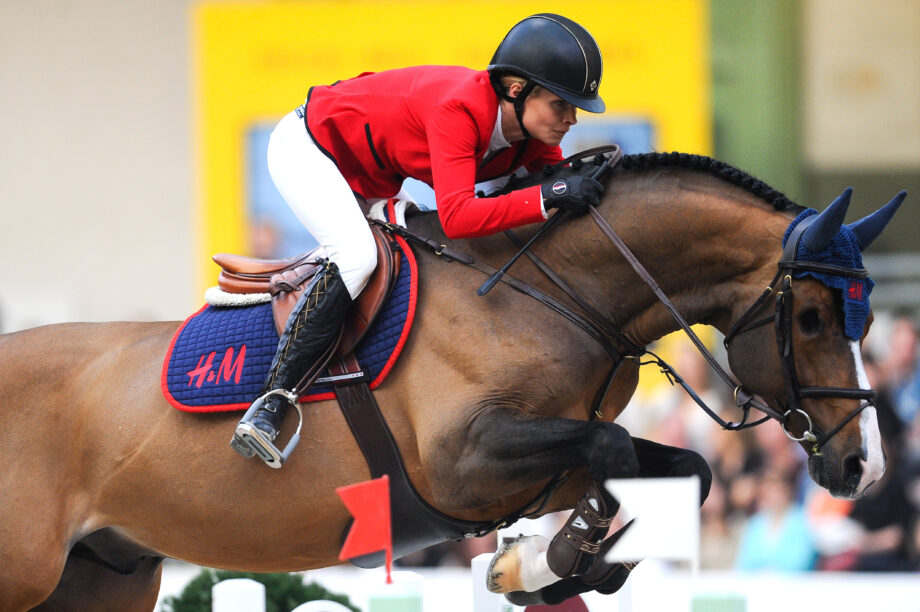Guard against sore, scratched or sun-damaged eyes this summer, with advice from Ria Chalder MRCVS
Summer can play havoc with a horse’s eyes, with flies, UV light, pollen and dry vegetation all posing potential risks.
Houseflies (the small, black pest termed Musca domestica) are attracted to the tears produced by a horse’s eyes and can often be seen swarming around the face. As they feed and breed on sewage, animal dung and other waste products, they can transfer bacteria on to the eyes and cause an infection called bacterial conjunctivitis.
{"content":"PHA+T2Z0ZW4gcmVmZXJyZWQgdG8gYXMg4oCcZmx5IGV5ZeKAnSwgYmFjdGVyaWFsIGNvbmp1bmN0aXZpdGlzIGNhbiBtYWtlIHRoZSBleWVzIHdlZXB5IGFuZCByZWQg4oCTIG9mdGVuIHdpdGggYSBncmVlbnkteWVsbG93IGRpc2NoYXJnZS4gVGhlIGNvbmRpdGlvbiBpcyBub3QgcGFydGljdWxhcmx5IHBhaW5mdWwuIEEgbWlsZCBib3V0IGNhbiB1c3VhbGx5IGJlIG1hbmFnZWQgYnkgYmF0aGluZyB0aGUgZXllcyB0d2ljZSBkYWlseSB3aXRoIGNvdHRvbiB3b29sIHBhZHMgc29ha2VkIGluIHN0ZXJpbGUgc2FsaW5lLCBvciBzYWx0eSB3YXRlciB0aGF0IGhhcyBiZWVuIGJvaWxlZCBhbmQgbGVmdCB0byBjb29sLiBUaGUgZXllcyBzaG91bGQgdGhlbiBiZSBjb3ZlcmVkIHdpdGggYSBnb29kLXF1YWxpdHkgZmx5IG1hc2sgdG8gcHJldmVudCByZS1pbmZlY3Rpb24uPC9wPgo8cD5JZiB0aGlzIGZhaWxzIHRvIGltcHJvdmUgc3ltcHRvbXMgd2l0aGluIGEgZGF5IG9yIHR3bywgY2FsbCB5b3VyIHZldC4gQW55IHNpZ24gdGhhdCB5b3VyIGhvcnNlIGlzIHNxdWludGluZywgb3IgdGhhdCBvbmUgb3IgYm90aCBleWVzIHNlZW0gcGFpbmZ1bCwgc2hvdWxkIGJlIHRyZWF0ZWQgYXMgYSB2ZXRlcmluYXJ5IGVtZXJnZW5jeS48L3A+CjxwPk5ldmVyIGJ1eSBvdmVyLXRoZS1jb3VudGVyIGV5ZSBkcm9wcyBmb3IgaHVtYW5zIHRvIHRyZWF0IHlvdXIgaG9yc2UgaWYgeW91IHN1c3BlY3QgdGhhdCBoZSBoYXMgYmFjdGVyaWFsIGNvbmp1bmN0aXZpdGlzLiBVc2luZyBhbnRpYmlvdGljIGRyb3BzIHdpdGhvdXQgdmV0ZXJpbmFyeSBzdXBlcnZpc2lvbiBpbmNyZWFzZXMgdGhlIGxpa2VsaWhvb2Qgb2YgcmVzaXN0YW50IOKAnHN1cGVyYnVnc+KAnSBkZXZlbG9waW5nLCB3aGljaCBjYW4gbWFrZSB0cmVhdG1lbnQgb2Ygc3Vic2VxdWVudCwgbW9yZSBzZXJpb3VzIGluZmVjdGlvbnMgZGlmZmljdWx0LiBJdCBhbHNvIGNvbXBsaWNhdGVzIG1hdHRlcnMgaWYgdGhlIGluZmVjdGlvbiBmYWlscyB0byByZXNvbHZlIGFuZCBkaWFnbm9zdGljIHRlc3RzIGFyZSByZXF1aXJlZC48L3A+CjxwPjxkaXYgY2xhc3M9ImFkLWNvbnRhaW5lciBhZC1jb250YWluZXItLW1vYmlsZSI+PGRpdiBpZD0icG9zdC1pbmxpbmUtMiIgY2xhc3M9ImlwYy1hZHZlcnQiPjwvZGl2PjwvZGl2PjxzZWN0aW9uIGlkPSJlbWJlZF9jb2RlLTMxIiBjbGFzcz0iaGlkZGVuLW1kIGhpZGRlbi1sZyBzLWNvbnRhaW5lciBzdGlja3ktYW5jaG9yIGhpZGUtd2lkZ2V0LXRpdGxlIHdpZGdldF9lbWJlZF9jb2RlIHByZW1pdW1faW5saW5lXzIiPjxzZWN0aW9uIGNsYXNzPSJzLWNvbnRhaW5lciBsaXN0aW5nLS1zaW5nbGUgbGlzdGluZy0tc2luZ2xlLXNoYXJldGhyb3VnaCBpbWFnZS1hc3BlY3QtbGFuZHNjYXBlIGRlZmF1bHQgc2hhcmV0aHJvdWdoLWFkIHNoYXJldGhyb3VnaC1hZC1oaWRkZW4iPg0KICA8ZGl2IGNsYXNzPSJzLWNvbnRhaW5lcl9faW5uZXIiPg0KICAgIDx1bD4NCiAgICAgIDxsaSBpZD0ibmF0aXZlLWNvbnRlbnQtbW9iaWxlIiBjbGFzcz0ibGlzdGluZy1pdGVtIj4NCiAgICAgIDwvbGk+DQogICAgPC91bD4NCiAgPC9kaXY+DQo8L3NlY3Rpb24+PC9zZWN0aW9uPjwvcD4KPHA+QSBjb3JyZWN0bHkgZml0dGluZyBtYXNrIHRoYXQgY29tcGxldGVseSBjb3ZlcnMgdGhlIGV5ZXMsIGluIGNvbWJpbmF0aW9uIHdpdGggYSBzdHJvbmcgaW5zZWN0IHJlcGVsbGVudCwgd2lsbCBnbyBhIGxvbmcgd2F5IHRvIHByZXZlbnRpbmcgYmFjdGVyaWFsIGNvbmp1bmN0aXZpdGlzLiBIb21lbWFkZSBmbHkgcmVwZWxsZW50cyBhcmUgcmFyZWx5IGVmZmVjdGl2ZS4gSW5zdGVhZCwgdHJ5IG9uZSBjb250YWluaW5nIGF0IGxlYXN0IDIlIHBlcm1ldGhyaW4sIG9yIGEgc3ludGhldGljIHB5cmV0aHJvaWQgc3VjaCBhcyBjeXBlcm1ldGhyaW4uPC9wPgo8aDM+TGlnaHQgcmVsaWVmPC9oMz4KPHA+SW4gaHVtYW5zLCBsb25nLXRlcm0gZXhwb3N1cmUgdG8gZXhjZXNzaXZlIGFtb3VudHMgb2YgVVYgbGlnaHQgZnJvbSB0aGUgc3VuIGhhcyBiZWVuIGxpbmtlZCB0byBkYW1hZ2UgdG8gdGhlIHJldGluYSwgYXQgdGhlIGJhY2sgb2YgdGhlIGV5ZSwgYW5kIHRoZSBmb3JtYXRpb24gb2YgY2F0YXJhY3RzLiBUaGVzZSBhYm5vcm1hbGl0aWVzIHRlbmQgdG8gZGV2ZWxvcCBhZnRlciBkZWNhZGVzOyBzaW5jZSBob3JzZXMgaGF2ZSBhIHNob3J0ZXIgbGlmZXNwYW4sIFVWLWluZHVjZWQgZGFtYWdlIGluc2lkZSB0aGUgZXllIGlzIGxlc3Mgb2YgYSBjb25jZXJuLjwvcD4KPHA+RXZlbiBzbywgdGhlc2UgaW52aXNpYmxlIHJheXMgaGF2ZSBhIGxvdCB0byBhbnN3ZXIgZm9yIHdoZW4gaXQgY29tZXMgdG8gZXF1aW5lIGV5ZSBwcm9ibGVtcy48L3A+CjxkaXYgY2xhc3M9ImFkLWNvbnRhaW5lciBhZC1jb250YWluZXItLW1vYmlsZSI+PGRpdiBpZD0icG9zdC1pbmxpbmUtMyIgY2xhc3M9ImlwYy1hZHZlcnQiPjwvZGl2PjwvZGl2Pgo8cD5VViBsaWdodCBpcyBwYXJ0bHkgcmVzcG9uc2libGUgZm9yIGEgdHlwZSBvZiBjYW5jZXIgY2FsbGVkIDxhIGhyZWY9Imh0dHBzOi8vd3d3LmhvcnNlYW5kaG91bmQuY28udWsvcGx1cy9uZXdzLXBsdXMvc2NpZW50aWZpYy1icmVha3Rocm91Z2gtc3F1YW1vdXMtY2VsbC1jYXJjaW5vbWEtY2FuY2VyLWVxdWluZS1odW1hbi1oaC1wbHVzLTcxNjA4NyI+b2N1bGFyIHNxdWFtb3VzIGNlbGwgY2FyY2lub21hPC9hPiAoU0NDKS4gVHVtb3VycyBjYW4gZGV2ZWxvcCBpbiBzZXZlcmFsIGxvY2F0aW9ucyBvbiBvciBhcm91bmQgdGhlIGV5ZSwgaW5jbHVkaW5nIHRoZSBza2luLCB0aGUgbWVtYnJhbmUgdGhhdCBsaW5lcyB0aGUgaW5zaWRlIG9mIHRoZSBleWVsaWRzICh0aGUgY29uanVuY3RpdmEpLCB0aGUgdGhpcmQgZXllbGlkIGFuZCB0aGUgY2xlYXIgY29ybmVhIGF0IHRoZSBmcm9udC48L3A+CjxwPlRoZSB0dW1vdXJzIGFyZSB1c3VhbGx5IHBpbmssIHJhaXNlZCBub2R1bGVzIHdpdGggYSByb3VnaCBhcHBlYXJhbmNlIGFuZCB0ZW5kIHRvIGNhdXNlIGEgdGhpY2ssIHdoaXRpc2gteWVsbG93IGV5ZSBkaXNjaGFyZ2UuIEZvcnR1bmF0ZWx5LCB0aGlzIHR5cGUgb2YgdHVtb3VyIGRvZXMgbm90IHRlbmQgdG8gc3ByZWFkIGludGVybmFsbHksIGJ1dCBpdCBjYW4gaW52YWRlIGltcG9ydGFudCBzdHJ1Y3R1cmVzIGluIHRoZSBhcmVhLjwvcD4KPGRpdiBjbGFzcz0iYWQtY29udGFpbmVyIGFkLWNvbnRhaW5lci0tbW9iaWxlIj48ZGl2IGlkPSJwb3N0LWlubGluZS00IiBjbGFzcz0iaXBjLWFkdmVydCI+PC9kaXY+PC9kaXY+CjxwPkhvcnNlcyB3aXRoIHBpbmsgc2tpbiBhcm91bmQgdGhlaXIgZXllcyBhcmUgYXQgZ3JlYXRlciByaXNrIG9mIGRldmVsb3Bpbmcgb2N1bGFyIFNDQywgYXMgYXJlIGNlcnRhaW4gYnJlZWRzIGluY2x1ZGluZyBCZWxnaWFuIERyYXVnaHRzIGFuZCBIYWZsaW5nZXJzLiBJZiB5b3VyIHZldCBzdXNwZWN0cyB0aGF0IHlvdXIgaG9yc2UgaGFzIGFuIG9jdWxhciBTQ0MsIGl0IG1heSBiZSBuZWNlc3NhcnkgdG8gdGFrZSBhIHNhbXBsZSBvZiB0aGUgdGlzc3VlLCBrbm93biBhcyBhIGJpb3BzeSwgd2hpY2ggY2FuIGJlIHNlbnQgZm9yIGFuYWx5c2lzIHRvIGNvbmZpcm0gdGhlIGRpYWdub3Npcy48L3A+CjxwPlRyZWF0bWVudCBvcHRpb25zIGRlcGVuZCBvbiB0aGUgbG9jYXRpb24gYW5kL29yIHNpemUgb2YgdGhlIHR1bW91ci4gUmVtb3ZhbCBvZiB0aGUgdHVtb3VyIGlzIHJlY29tbWVuZGVkLCBpbiBjb21iaW5hdGlvbiB3aXRoIGFuIGFkZGl0aW9uYWwgdHJlYXRtZW50IHN1Y2ggYXMgY2hlbW90aGVyYXB5IChpbiB0aGUgZm9ybSBvZiBjcmVhbXMgYW5kIGluamVjdGFibGVzKSwgcmFkaWF0aW9uIHRoZXJhcHksIHBob3RvZHluYW1pYyB0aGVyYXB5IG9yIGZyZWV6aW5nIChjcnlvdGhlcmFweSkuPC9wPgo8ZGl2IGNsYXNzPSJhZC1jb250YWluZXIgYWQtY29udGFpbmVyLS1tb2JpbGUiPjxkaXYgaWQ9InBvc3QtaW5saW5lLTUiIGNsYXNzPSJpcGMtYWR2ZXJ0Ij48L2Rpdj48L2Rpdj4KPHA+VHVtb3VycyBjYW4gcmVjdXIsIGhvd2V2ZXIsIGFmdGVyIHRyZWF0bWVudC4gUmVzZWFyY2hlcnMgaW4gQW1lcmljYSBmb3VuZCB0aGF0IHRoZSBvbmx5IGZhY3RvciBhc3NvY2lhdGVkIHdpdGggYSBkZWNyZWFzZWQgcmlzayBvZiBvY3VsYXIgU0NDIHJlY3VycmVuY2Ugd2FzIHRoZSB1c2Ugb2YgYSBmbHkgbWFzayB3aXRoIDkwJSBvciBtb3JlIFVWIGxpZ2h0IHByb3RlY3Rpb24uPC9wPgo8cD5BbHRob3VnaCBub3QgcHJvdmVuLCBVViBsaWdodCBhbHNvIGFwcGVhcnMgdG8gdHJpZ2dlciBmbGFyZS11cHMgb2YgPGEgaHJlZj0iaHR0cHM6Ly93d3cuaG9yc2VhbmRob3VuZC5jby51ay9ob3JzZS1jYXJlL3ZldC1hZHZpY2UvZXF1aW5lLXJlY3VycmVudC11dmVpdGlzLW1vb24tYmxpbmRuZXNzLTU3MzEwIj5lcXVpbmUgcmVjdXJyZW50IHV2ZWl0aXM8L2E+IChFUlUpIOKAkyBhIGNvbmRpdGlvbiB0aGF0IGNhdXNlcyByZWN1cnJlbnQgYm91dHMgb2YgcGFpbmZ1bCBpbmZsYW1tYXRpb24gaW5zaWRlIHRoZSBleWUgYW5kIGlzIHRoZSBsZWFkaW5nIGNhdXNlIG9mIGJsaW5kbmVzcy4gV2hpbGUgRVJVIGlzIHN0aWxsIHBvb3JseSB1bmRlcnN0b29kLCBvd25lcnMgb2YgYWZmZWN0ZWQgaG9yc2VzIHdpbGwgdGVzdGlmeSB0aGF0IHRoZSBzdW4gYW5kIHdpbmQgYXJlIG1ham9yIGNvbnRyaWJ1dGluZyBmYWN0b3JzIHRvIGFuIGVwaXNvZGUgb2YgdGhpcyBkZXZhc3RhdGluZyBkaXNlYXNlLjwvcD4KPHA+QWdhaW4sIGl0IGlzIGFkdmlzYWJsZSB0byB1c2UgYSBmbHkgbWFzayB0aGF0IGFsc28gYmxvY2tzIGhhcm1mdWwgVVYgcmF5cy4gU3VuIHZpc29ycyBhcmUgbm93IGF2YWlsYWJsZSBmb3IgdXNlIHdoaWxlIHRoZSBob3JzZSBpcyBiZWluZyByaWRkZW4sIG9mZmVyaW5nIDEwMCUgVVYgcHJvdGVjdGlvbi48L3A+CjxoMz5JdGNoIGFuZCBzY3JhdGNoPC9oMz4KPHA+V2FybWVyLCBkcmllciB3ZWF0aGVyIHdpbGwgYWxzbyBzZWUgYW4gaW5jcmVhc2UgaW4gdGhlIG9jY3VycmVuY2Ugb2YgY29ybmVhbCB1bGNlcnMsIHRoZSB0ZXJtIGZvciBzY3JhdGNoZXMgb24gdGhlIHN1cmZhY2Ugb2YgdGhlIGV5ZS4gQXMgdHJlZXMgYW5kIGJ1c2hlcyBiZWNvbWUgZHJ5IGFuZCBzcGlreSwgYSBob3JzZeKAmXMgcHJvbWluZW50bHkgcG9zaXRpb25lZCBleWVzIGFyZSB2dWxuZXJhYmxlIHRvIHNjcmF0Y2hlcyBhcyBoZSBncmF6ZXMuPC9wPgo8cD5UaGUgcHJvYmxlbSBpcyB1c3VhbGx5IG9idmlvdXMsIGFzIHRoZSBwYWluIHdpbGwgY2F1c2UgeW91ciBob3JzZSB0byBzcXVpbnQgYW5kIHRoZSBleWUgdG8gd2F0ZXIuIEFuZCB0aGUgb2ZmZW5kaW5nIHBpZWNlIG9mIHR3aWcgb3IgdGhvcm4gbWF5IHN0aWxsIGJlIHNlZW4gZW1iZWRkZWQgaW4gdGhlIHN1cmZhY2Ugb2YgdGhlIGV5ZS48L3A+CjxwPkEgY29ybmVhbCB1bGNlciByZXF1aXJlcyBpbW1lZGlhdGUgdmV0ZXJpbmFyeSBhdHRlbnRpb24uIFlvdXIgdmV0IHdpbGwgbW9zdCBsaWtlbHkgc3RhaW4gdGhlIHN1cmZhY2Ugb2YgdGhlIGV5ZSB3aXRoIGEgZ3JlZW4gZHllIGNhbGxlZCBmbHVvcmVzY2VpbiB0byBkZXRlcm1pbmUgdGhlIHNpemUgYW5kIGRlcHRoIG9mIHRoZSB1bGNlci4gUHJvbXB0IHRyZWF0bWVudCwgaW5jbHVkaW5nIHBhaW4gcmVsaWVmIGFuZCBmcmVxdWVudCBhcHBsaWNhdGlvbiBvZiBhbnRpYmlvdGljIGV5ZSBkcm9wcywgaXMgdGhlbiBlc3NlbnRpYWwgdG8gcHJldmVudCBzaWdodC10aHJlYXRlbmluZyBpbmZlY3Rpb24uPC9wPgo8cD5JdGNoeSBleWVzLCBhbHNvIGNvbW1vbiBkdXJpbmcgc3ByaW5nIGFuZCBzdW1tZXIsIGNhbiBiZSBhIHNpZ24gb2YgYW4gYWxsZXJnaWMgcmVhY3Rpb24gc3VjaCBhcyBhbGxlcmdpYyBjb25qdW5jdGl2aXRpcy4gVGhlIGV5ZXMgd2lsbCB0ZW5kIHRvIGJlIHB1ZmZ5LCB0aGUgY29uanVuY3RpdmEgYnJpZ2h0IHBpbmsgYW5kIHRoZSBleWVzIHNsaWdodGx5IHdhdGVyeS48L3A+CjxwPlRyZWF0bWVudCBpcyBzaW1pbGFyIHRvIHRoYXQgb2YgaGF5IGZldmVyIGluIGh1bWFuczogYXZvaWQgdGhlIHRyaWdnZXIuIElmIHlvdXIgaG9yc2XigJlzIHNpZ25zIHdvcnNlbiB3aGVuIHRoZSBwb2xsZW4gY291bnQgaXMgaGlnaCwgZm9yIGV4YW1wbGUsIHRyeSB0byBrZWVwIGhpbSBzdGFibGVkIGR1cmluZyB0aGUgZGF5LjwvcD4KPHA+QWx0aG91Z2ggaXQgbWF5IHNlZW0gYSByZWxhdGl2ZWx5IHRyaXZpYWwgZGlzZWFzZSwgaXQgaXMgaW1wb3J0YW50IHRvIGFkZHJlc3MgYWxsZXJnaWMgY29uanVuY3Rpdml0aXMgd2l0aCB0aGUgaGVscCBvZiB5b3VyIHZldC4gQSBob3JzZSBtYXkgdHJ5IHRvIHJ1YiBoaXMgaXRjaHkgZXllcyBhZ2FpbnN0IHNoYXJwIGVkZ2VzLCBwb3RlbnRpYWxseSBpbmp1cmluZyBoaW1zZWxmLiBJZiB0aGV5IGFyZSBzbyBpdGNoeSB0aGF0IHRoZSBob3JzZSBpcyBzZWxmLXRyYXVtYXRpc2luZyB0aGUgZXllIGFyZWEsIHlvdXIgdmV0IG1heSBhZG1pbmlzdGVyIHN0cm9uZyBhbnRpLWluZmxhbW1hdG9yeSBtZWRpY2F0aW9ucyB0byBwcm92aWRlIGltbWVkaWF0ZSByZWxpZWYuPC9wPgo8cD5XaGlsZSBhbnRpaGlzdGFtaW5lcyBhcmUgYWxzbyBjb21tb25seSB1c2VkIHRvIGhlbHAgcmVsaWV2ZSB0aGUgY2xpbmljYWwgc2lnbnMgb2YgYWxsZXJnaWVzLCB0aGVpciBlZmZpY2FjeSBpbiBob3JzZXMgaXMgbm90IHdlbGwgdW5kZXJzdG9vZC4gVGhleSBhcHBlYXIgdG8gd29yayBiZXN0IGFzIGEgcHJldmVudGF0aXZlIG1lYXN1cmUgYmVmb3JlIHRoZSBiZWdpbm5pbmcgb2YgdGhlIGFsbGVyZ3kgc2Vhc29uLCByYXRoZXIgdGhhbiBvbmNlIGEgaG9yc2UgaXMgaXRjaHkuIElmIGhlIGlzIGFmZmVjdGVkIHRoaXMgc3VtbWVyLCBpdOKAmXMgd29ydGggcGxhbm5pbmcgYWhlYWQgbmV4dCB5ZWFyLjwvcD4KPGgzPkNob29zaW5nIGFuZCB1c2luZyBwcm90ZWN0aXZlIGZseSBtYXNrczwvaDM+CjxwPkZseSBmcmluZ2VzIGFyZSByZWxhdGl2ZWx5IGluZWZmZWN0aXZlIGFuZCBkbyBub3QgcHJvdmlkZSBhbnkgVVYgcHJvdGVjdGlvbiwgc28gYXJlIGJlc3QgYXZvaWRlZC4gSW5zdGVhZCwgb3B0IGZvciBhIG1lc2ggZmx5IG1hc2sgdGhhdCBjb3ZlcnMgdGhlIGV5ZXMg4oCTIHRoaXMgd2lsbCBub3Qgb25seSBrZWVwIGJ1Z3MgYXdheSwgYnV0IHdpbGwgc2hpZWxkIHRoZSBleWVzIGZyb20gc2hhcnAgb2JqZWN0cyBhbmQgZm9yZWlnbiBib2RpZXMgd2hpbGUgaGUgZ3JhemVzLjwvcD4KPHA+SW52ZXN0IGluIGEgcXVhbGl0eSBtYXNrIHdpdGggaGlnaCBVViBwcm90ZWN0aW9uIHByb3BlcnRpZXMsIHRha2luZyBjYXJlIHRvOjwvcD4KPHA+4pePIE1ha2Ugc3VyZSBpdCBmaXRzLiBUb28gbG9vc2UgYW5kIHRoZSBtYXNrIHdpbGwgYWxsb3cgZmxpZXMgdG8gY3Jhd2wgdW5kZXJuZWF0aCBpdDsgdG9vIHRpZ2h0IGFuZCBpdCB3aWxsIGNoYWZlIHRoZSBza2luLiBBbiBpbGwtZml0dGluZyBtYXNrIG1heSBldmVuIHJ1YiB0aGUgZXllbGFzaGVzIG9yIHB1c2ggdGhlbSBvbiB0byB0aGUgc3VyZmFjZSBvZiB0aGUgZXllLCBjYXVzaW5nIHNlcmlvdXMgaW5qdXJ5LiBBIGdvb2QgZGVzaWduIHdpbGwgZmVhdHVyZSBzZXZlcmFsIGRhcnRzIGFyb3VuZCB0aGUgZXllIGFyZWEsIHRvIGVuc3VyZSB0aGF0PGJyIC8+CnRoZSBtZXNoIHNpdHMgd2VsbCBjbGVhci4gQWRkaXRpb25hbCBmZWF0dXJlcyBtYXkgaW5jbHVkZSBhZGp1c3RhYmxlIGZhc3RlbmluZ3MgYW5kIHNvZnQgcGFkZGluZyBhdCB0aGUgYnJvdyBhbmQgYXJvdW5kIHRoZSBub3NlIGZvciBjb21mb3J0LjwvcD4KPGRpdiBjbGFzcz0iaW5qZWN0aW9uIj48L2Rpdj4KPHA+4pePIEtlZXAgaXQgY2xlYW4uIEEgZGlydHkgbWFzayB3aWxsIHNoZWQgZHVzdCBpbnRvIGEgaG9yc2XigJlzIGV5ZXMgYW5kPGJyIC8+CmNhbiBtYWtlIHByb2JsZW1zIHdvcnNlLCBzbyBzaGFrZSB0aGUgbWFzayBvdXQgZWFjaCB0aW1lIGl0IGlzIGZpdHRlZCBhbmQgY2xlYW4gaXQgcmVndWxhcmx5LiBBIG1hY2hpbmUtd2FzaGFibGUgdmVyc2lvbiB3aWxsIG1ha2UgdGhpcyBlYXNpZXIuPC9wPgo8cD7il48gQ2hlY2sgaXQgZnJlcXVlbnRseS4gRXZlbiBpZiB5b3UgYXJlIG5vdCByaWRpbmcgeW91ciBob3JzZSwgdGFrZSB0aGUgbWFzayBvZmYgYXQgbGVhc3Qgb25jZSBhIGRheSB0byBjaGVjayBoaXMgZXllcyBhbmQgdG8gZW5zdXJlIHRoYXQgaGUgaXMgbm90IGJlaW5nIHJ1YmJlZC48L3A+CjxwPjxlbT5SZWYgSG9yc2UgJmFtcDsgSG91bmQ7IDExIEp1bmUgMjAyMDwvZW0+PC9wPgo8cD4K"}
You may also be interested in…
Credit: Lucy Merrell
Our new occasional series zooms in on the equine eye. Looking into this complex device can offer vital clues about
Credit: David Ramos/Getty Images
Credit: Lucy Merrell
‘Owner recognition of disease is important as they are the persons responsible for presenting animals for veterinary care’
Eye tumours and cysts are some of the most common equine ophthalmic problems. Philip Ivens MRCVS reveals how pioneering methods





